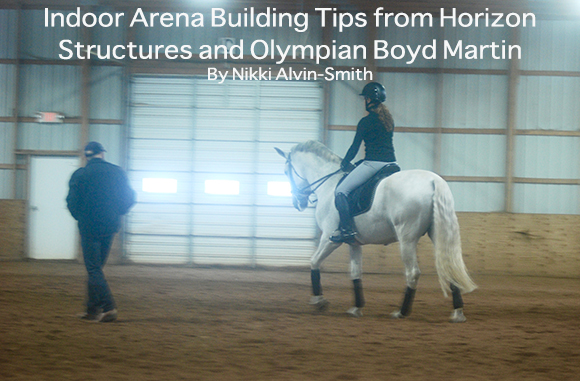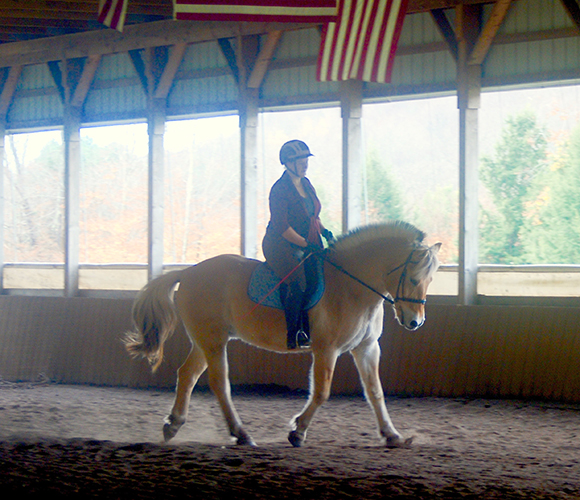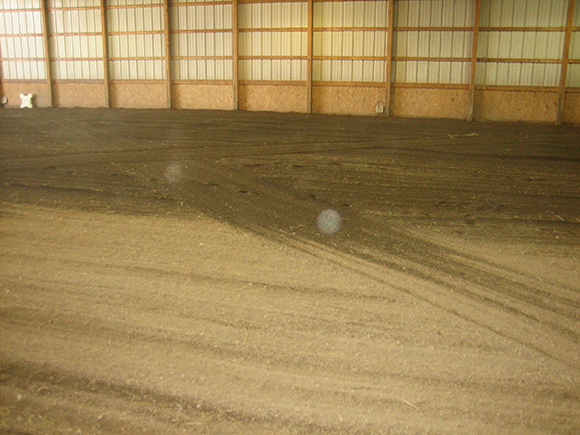Indoor Arena Building Tips from Horizon Structures and Olympian Boyd Martin
By Nikki Alvin-Smith

Building an indoor arena is a big project and one that we all get super excited about.
Don’t let your dream indoor arena become a nightmare because of lack of knowledge or poor planning. There are many pitfalls you need to avoid so here are some tips from both sides of the table; top flight equestrian and Olympic event rider Boyd Martin chats on video about what he finds important in an indoor arena build; Horizon Structures, Atglen, PA, shares advice on top ten things to consider when you decide to build that will save you heartache and help make your dream indoor a reality. With thanks to both parties for sharing their wealth of experience!
As an Olympic Eventer Boyd spends much of his time schooling horses outside, over cross-country courses and stadium fences. But as Boyd explains weather can get in the way of training schedules and an indoor arena can help keep things on track. Click here to hear his personal account of what he likes to see in an indoor arena build.
Horizon Structures are experts in the construction of everything equine (plus structures for dogs, goats, chickens too). From modular horse barns to on site construction, Horizon Structures bring a wealth of experience and a deep well of satisfied clientele to boot. Here are their top ten tips on indoor arena planning.
A Place for Everything
Where you site your arena will directly affect the price of site preparation. Choose an area that is as level as possible to avoid extra costs for soil removal, rock excavation and drainage issues. If your site needs to be built up on one side to make a level area, allow time for the material to settle before building and be certain the entire site is well compacted. Today’s technology means many bulldozers have laser level abilities and the operator can ensure that the entire site is level to within an inch. Now is the time to lay the foundation for the footing. Most contractors will recommend a gravel layer with stone dust compacted on top. This will then be ready for the installation of footing materials later on. I personally don’t recommend installing the footing before the build as the heavy equipment, lifts etc. may damage it and it also provides a great place for errant nails to hide. Once the building is complete I recommend combing the entire arena with a magnet to pick up any nails or other hazards. In the case of aluminum nails you’ll need to search by eye.
When leveling the site situate drainage and remember that water will flow downhill and off the roof. Gutters on the building are a must have. Ensure that you face the building to avoid prevailing winds tugging at the doors. The gable end is the best place to install doors, as the gable ends won’t be subject to snowfall from the roof.
Avoid placing the building next to tree lines as the compaction of the site for the arena may affect their growth and perhaps even result in the trees dying. Unhealthy trees quickly become a hazard during high winds as they may fall onto the building.
To prevent mud and puddles always add a 10-foot contingency apron around the building in addition to drainage.
Size Matters
The standard for useful riding space is 70 to 80 feet wide. The length truly depends on the discipline you ride. For a dressage rider it is possible to work with a training level size arena that is 120 feet long, but ideally the arena you build should be large enough to accommodate more than one horse and rider using the arena at the same time and every dressage rider should expect they’ll transcend training level and want a full size space. For other disciplines such a showjumping, the arena needs to be wide enough to facilitate turns between fences. If you expect to have auditors and other visitors allow space at the end or side of the arena to provide a safe zone for them to stand or sit. Also consider if you want a viewing room, either one level or two.
It is important to also carefully consider the height of the building. For jumpers the trusses, need to be high enough that there is no danger of a mounted rider hitting their head on them over the fence. Allow space for lighting fixtures in your equation for the height needed. A standard height is 18 feet. Height is also important for the use of equipment to both rake the footing and to access the building for repairs, lighting, footing installation and future replacement. Tall and wide doors, 16 feet high or better are a boon for pulling in loaded hay wagons out of the weather, accessing with tractors and other equipment. Many professionals bring their horse trailers in the indoor to load up equipment for long hauls and to load horses in a controlled environment.
Light and Airy
The more natural light your arena features the less you’ll need to spend on the electric bill. Consult your local power company before you add lighting because many companies offer grants and free advice on energy saving fixtures. Light panels at the top of the sidewalls are preferable to roof light panels as the interior of the roof may become dusty and you may not be able to reach it to clean it. Side light panels are also less expensive to install and offer more light, as they are generally larger in area.

Quality of Materials
All builders and construction companies are not equal and their workmanship and quality of materials used will vary considerably. It is paramount that the trusses and entire structural plans are professionally certified and designed by a licensed engineer, even if your local building office does not require any permits for agricultural buildings. The pillars must be properly cemented to a correct depth to ensure no frost heave, the truss system must not just offer a clear span riding area for safety, but it must also meet and hopefully exceed the snowload requirements for your area. This is not an area on which to skimp. I personally know of several indoors where the roof is shingle and the truss system inadequate, and the snow has to be manually removed each year when it reaches a certain depth. This is dangerous and should be avoided at all costs.
To avoid condensation also consider having the roof insulated. An insulated roof will also improve acoustics and defray heat retention from the roof in summer months, if the roof is metal.
Also remember snow will slide off a metal roof and be deposited on the ground alongside the arena. This may require removal if your exterior space is limited.
Safety First
The addition of an angled knee wall or rider guard wall is a good idea to prevent horses hitting the wall with their hooves and most importantly to protect the rider’s knees from suffering damage from impact on a pillar or wall. The material used should be sturdy, as the wall will take some abuse over time. A knee wall is also a useful way to improve the interior appearance of the building as it breaks up the sight line to the roof.
Aside from the huge doors to access the building with large equipment, also include at least one regular door for human access. If you plan to use your indoor for public use one exit door will be required on each side of the building, so check with your Building Officer for local requirements.
Access is also important. Allow for parking for visitors and lay in a driveway so that heavy equipment can access the site easily during the build and afterward for repairs and deliveries.
Do not forget to include the costs of footing materials in your budget. Good footing is important for the soundness of the horse and for the safe use of the arena for turns in jumping and barrel racing. While sand and rubber based footings are common and sand is the cheapest option, there are a myriad of footing options and some are extremely expensive. It is sometimes possible to buy footing from public venues that are replacing their footing materials for a discounted cost. Expect to replace footing periodically. I don’t know where it disappears to but it does!

Is it Permitted?
Before you get too far into planning this important project consult your local Building Officer to find out what permits and licenses are required. A good construction company will provide all the plans that are required and aid you in making any necessary adjustments before the build begins. Code enforcement is an important part of building safety. Do not consider the expectations of your Town Building Officer an adverse requirement, the Zoning and Building Officer are there to protect you and your neighbors from poor building techniques.
Take Time to Plan
A big build such as an indoor arena takes careful consideration. Allow yourself plenty of time to research the details and to design what you need. Remember the larger the build the more expensive it will be not just to build, but to light, to install footing materials, and to maintain. If you wish to add extras like stalls along one side, it is more cost effective to add them now than later.
Apples to Apples
With the huge variety in options for construction companies and construction materials it is wise to consult with professionals that are experienced in building indoors. Some companies may cut corners, such as using undersized rough cut lumber instead of glue lam wood, not providing an inclusive quote but adding fees later, not including costs of manlifts or other equipment needed for the build, not providing correct spacing of trusses etc.
Warranty
Most building products come with a warranty against defect directly from the manufacturers. A good building company will provide not just references on their previous indoor arena builds, but also offer a warranty on their workmanship. An indoor arena is a major improvement to your property and a major expense so be prudent and do your due diligence before you designate the contractor and sign on the dotted line and hand over a deposit.
Finance Options
Horizon Structures can help with partial financing of the build through a 3rd party provider and this may expedite the process of obtaining financing. The application process is simple, safe and secure. Consult with a professional accountant to see how the building can be amortized as part of your business. The additional income that having an indoor for year round riding/lesson use can easily offset the monthly financing fees.
As a professional dressage rider I worked for 26 years without the benefit of an indoor arena. When I moved the first building constructed on the property was, you guessed it, an indoor arena! When training horses or students or both, the ability to train year around and also into the evening hours without worry about the weather or the hour, is extremely beneficial and very productive. You may be able to lease out the arena for events/clinics/shows and other activities such as dog agility events to also help defray the initial expenses. I think most equestrian professionals would agree.
Do not forget to include insurance costs in your budget. The indoor arena will add value to your property and its replacement cost should be insured. Also add appropriate liability coverage for your specific use of the building if it outside of personal use.
I hope that these guidelines will aid you in making your dream indoor a reality. With thanks to both Boyd Martin and Horizon Structures for their help! If you would like to chat with a friendly and professional expert at Horizon Structures give Mike Rinier a call at 888 447 4337, as Senior Project Manager he has lots of important advice to share to help you avoid making costly mistakes and can help you stay on budget, on time and on track! Lots more information also available on their website at https://www.HorizonStructures.com


